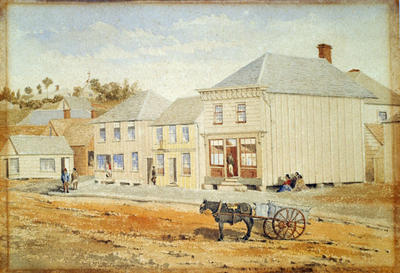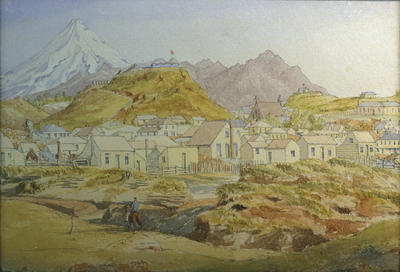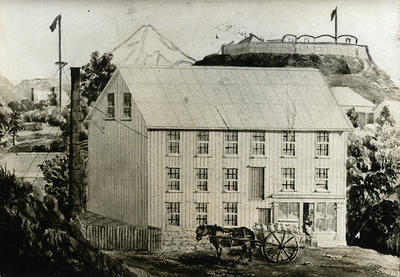Hamar Humphrey Arden
Details
Date of birth / Date established
1816
Date of death / Date closed
27 Nov 1895
Place of birth / Place established
Place of death / Place closed
Person/Corporate type
Individual
Biography
Born in England, son of watercolourist the Rev. Francis Edward Arden, Vicar of Gresham.
Hamar arrived in Taranaki with his wife Alice and family of three sons and two daughters in 1853 aboard the 'Cresswell' and according to newspaper accounts took up land at Willis Road (now Corbett Road), Bell Block. Within months of settling the Ardens found themselves literally in the midst of a Maori conflict, subsequently known as the 'Puketapu feud'. The cause of this conflict between the leading members of the Puketapu hapu was the sale of land, including that occupied by the Ardens, to the pakeha.
Although this conflict did not materially affect the Ardens, the Taranaki Land Wars which were soon to follow briought considerable changes to their lives. The onset of hostilities forced the family to flee their home and take refuge in New Plymouth.
Hamar at first moved the family to Nelson in 1860 but returned in 1861 to commence practice as a professional artist, the first to be permanently domiciled in the settlement.
He did a great number of watercolours, often of the same views of the township, then largely confined to the lower Huatoki Valley. In contrast to his son Francis, his known works are rarely 'topographical' and have more photographic than aesthetic qualities. The main characteristics of Hamar's work can be seen in these town views, the planes of buildings defined precisely, usually with a ruler, and yet otherwise his line wavers freely as he preferred to work directly with his brush. He simplified vegetation, hillsides and the slopes of the mountain into patches of colour that are often surprisingly vibrant.
There is little perspective in his work with the transition from near to far somewhat compressed. His layout typically emphasises the middle distance, where he liked to place buildings people and animals, while Egmont/Taranaki looms dramatically behind. His palette, although the colours have suffered variously with time, always appear warm and is often subtle, particularly on the sides and roofs of buildings.
For service in the Taranaki Volunteers he was granted confiscated land at Tikorangi. The Almanacs show that he practised as an artist into the 1870's in Gill Street, moving by 1877 to a property on Devon Street near the Eliot Street intersection and by 1888, the last date we have, at a Courtenay Street property.
Hamar arrived in Taranaki with his wife Alice and family of three sons and two daughters in 1853 aboard the 'Cresswell' and according to newspaper accounts took up land at Willis Road (now Corbett Road), Bell Block. Within months of settling the Ardens found themselves literally in the midst of a Maori conflict, subsequently known as the 'Puketapu feud'. The cause of this conflict between the leading members of the Puketapu hapu was the sale of land, including that occupied by the Ardens, to the pakeha.
Although this conflict did not materially affect the Ardens, the Taranaki Land Wars which were soon to follow briought considerable changes to their lives. The onset of hostilities forced the family to flee their home and take refuge in New Plymouth.
Hamar at first moved the family to Nelson in 1860 but returned in 1861 to commence practice as a professional artist, the first to be permanently domiciled in the settlement.
He did a great number of watercolours, often of the same views of the township, then largely confined to the lower Huatoki Valley. In contrast to his son Francis, his known works are rarely 'topographical' and have more photographic than aesthetic qualities. The main characteristics of Hamar's work can be seen in these town views, the planes of buildings defined precisely, usually with a ruler, and yet otherwise his line wavers freely as he preferred to work directly with his brush. He simplified vegetation, hillsides and the slopes of the mountain into patches of colour that are often surprisingly vibrant.
There is little perspective in his work with the transition from near to far somewhat compressed. His layout typically emphasises the middle distance, where he liked to place buildings people and animals, while Egmont/Taranaki looms dramatically behind. His palette, although the colours have suffered variously with time, always appear warm and is often subtle, particularly on the sides and roofs of buildings.
For service in the Taranaki Volunteers he was granted confiscated land at Tikorangi. The Almanacs show that he practised as an artist into the 1870's in Gill Street, moving by 1877 to a property on Devon Street near the Eliot Street intersection and by 1888, the last date we have, at a Courtenay Street property.

















![Untitled [Moturoa]; Circa 1880s; A65.899](https://collection.pukeariki.com/records/images/medium/8038/97e7b5b07c1cce3c1468bf3b7b7c8fb976c79db6.jpg)